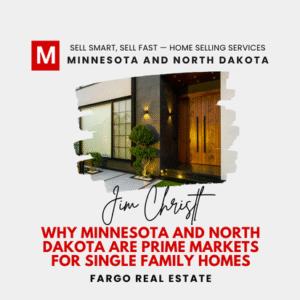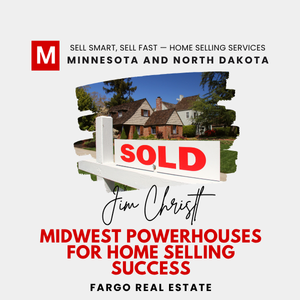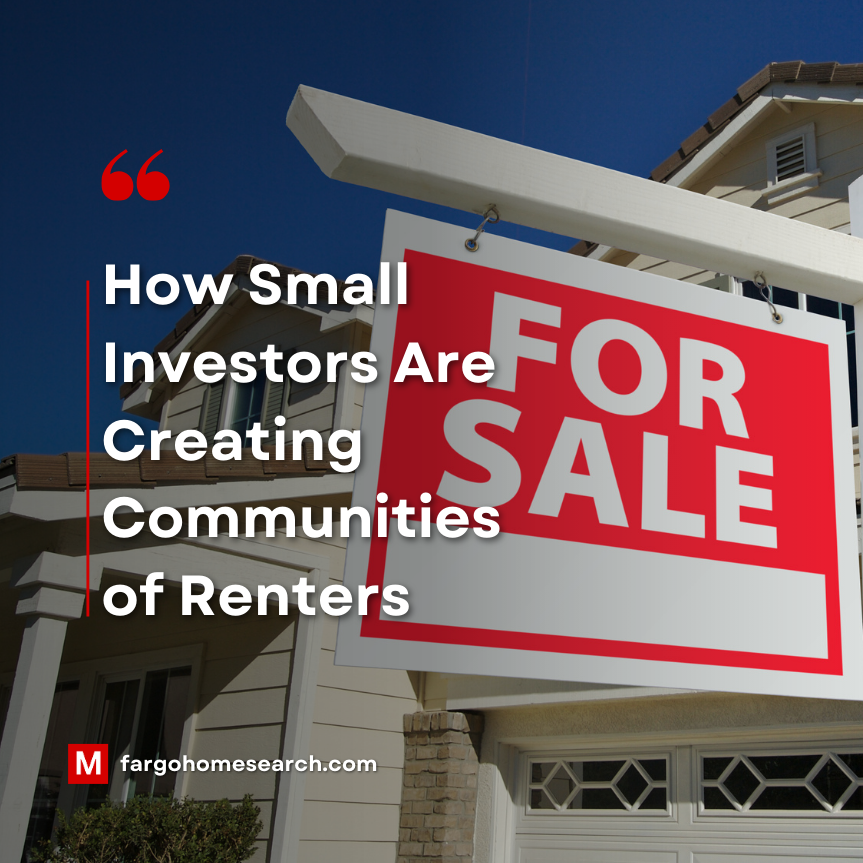Fargo–Moorhead to Twin Cities Exurbs: Growth Corridors to Watch
Minnesota and North Dakota offer compelling opportunities for Home  Buyers and Home Sellers looking to invest in single family homes and residential homes in 2025. These Midwestern states boast resilient economies, affordable residential homes, steady population and job growth, strong rental demand, and potential for appreciation, making them ideal for strategies like buy-and-hold, rentals, or short-term flips. Below, we explore why these markets are attractive for real estate investors, with a focus on single family homes, supported by current market data.
Buyers and Home Sellers looking to invest in single family homes and residential homes in 2025. These Midwestern states boast resilient economies, affordable residential homes, steady population and job growth, strong rental demand, and potential for appreciation, making them ideal for strategies like buy-and-hold, rentals, or short-term flips. Below, we explore why these markets are attractive for real estate investors, with a focus on single family homes, supported by current market data.
Minnesota Real Estate: A Hub for Residential Homes Investment
Minnesota’s market is a haven for Home Buyers seeking stability and growth, driven by a diverse economy in healthcare, finance, manufacturing, and education. The Twin Cities (Minneapolis-St. Paul) metro area is a hotspot for single family homes, with home sales up 1.8% year-over-year in 2024 despite national challenges. Statewide, residential homes prices rose 5.7% YoY as of January 2025, reflecting sustained demand amid low inventory, benefiting Home Sellers.
Key Factors for Investing in Minnesota Single Family Homes
| Key Factor | Details | Why It Benefits Investors |
|---|---|---|
| Affordability | Median price for single family homes: ~$335,000 (e.g., Rochester); affordability ratio of 2.2 in top markets like Eveleth. Lower than national averages for major metros. | Allows Home Buyers entry with lower capital; easier financing and higher ROI potential through rentals or appreciation of residential homes. |
| Rental Demand & Cash Flow | Gross median rent for residential homes competitive with U.S. average; strong student and professional markets in Minneapolis (e.g., University of Minnesota). Duplexes and single family homes in short supply, yielding passive income. | High occupancy rates for investors; tax benefits like depreciation and deductions on mortgage interest/property taxes enhance net yields for Home Sellers and landlords. |
| Economic & Population Growth | Booming healthcare (e.g., Mayo Clinic in Rochester, up 13.6% in prices); population growth from job opportunities and quality of life driving demand for single family homes. | Sustained housing demand; long-term appreciation in thriving areas like Waconia and Chaska benefits Home Sellers. |
| Market Stability | Low foreclosure rates; balanced market with gradual price increases. Top investment zips like 55734 (Eveleth) offer strong metrics for single family homes flips or holds. | Lower risk; predictable returns in a state with excellent schools and green spaces attracting Home Buyers to residential homes. |
Additional Notes for Minnesota Home Buyers and Sellers
Home Buyers and Home Sellers can leverage resources like the Minnesota Real Estate Investors Association (MnREIA) for networking and strategies tailored to single family homes. Minnesota suits conservative investors seeking reliable cash flow and moderate growth in residential homes.
North Dakota Real Estate: Affordable Single Family Homes and Strong Returns
North Dakota’s market, fueled by its energy sector (oil, agriculture) and low unemployment (~2-3%), is a magnet for Home Buyers eyeing single family homes. Inbound migration (58% of moves in 2025 for work) drives demand for residential homes. Median prices for single family homes hover around $302,000-$308,000, with a seller’s market due to limited supply (new listings down 21.2% YoY), benefiting Home Sellers. Homes sell in under 30 days on average, making it a dynamic market. Tools like FargoHomeSearch are invaluable for Home Buyers and Home Sellers exploring opportunities in Fargo’s booming market.
Key Factors for Investing in North Dakota Single Family Homes
| Key Factor | Details | Why It Benefits Investors |
|---|---|---|
| Affordability | Median price for single family homes: $308,100; affordability score of 4 (4 years of median income to buy). Lowest in regions like Grafton (ratio 1.9). | Budget-friendly entry for Home Buyers; high cash-on-cash returns, especially for rentals in energy hubs like Williston. |
| Rental Demand & Cash Flow | Stable rental market for residential homes with rising rents due to housing shortages; focus on long-term rentals in cities like Fargo and Bismarck, accessible via platforms like FargoHomeSearch. | Lucrative for landlords; low vacancy risks from workforce influx in tech, healthcare, and energy benefit Home Sellers leasing properties. |
| Economic & Population Growth | Thriving job market (24,000+ openings in 2025); universities like UND driving educated workforce retention, increasing demand for single family homes. | Boosts housing needs; urban-rural balance offers opportunities in metros (Fargo) and rural affordable residential homes initiatives. |
| Market Stability | Low unemployment and cost of living; upward price momentum with 7.2% of single family homes selling above list price. Top zips like 58237 (Grafton) excel in value/population metrics. | Resilient to downturns; potential for appreciation as infrastructure investments continue, aiding Home Sellers. |
Additional Notes for North Dakota Home Buyers and Sellers
North Dakota appeals to Home Buyers seeking energy-driven growth and affordability in single family homes. Platforms like FargoHomeSearch simplify finding residential homes in Fargo, a key market. Challenges like harsh winters are offset by energy-efficient property opportunities, benefiting Home Sellers. Both states provide lower-risk entry points compared to coastal markets, with Minnesota offering urban vibrancy and North Dakota emphasizing affordability and jobs. Diversifying across them could hedge against sector-specific risks.
Why Government Shutdowns Hurt Home Buyers and Sellers in Real Estate
Government shutdowns, like the ongoing one starting October 1, 2025, disrupt the market for single family homes and residential homes, impacting Home Buyers and Home Sellers. By halting federal programs, injecting economic uncertainty, and delaying transactions, shutdowns create challenges. Prolonged shutdowns (e.g., the 35-day 2018-2019 event) can shave 0.1% off quarterly GDP per week, exacerbating affordability issues in a sluggish market. Real estate, contributing ~20% to the U.S. economy, affects buyers, sellers, investors, agents, and builders of single family homes.
Key Impacts of Government Shutdowns on Residential Homes
Delayed or Halted Federal Programs Critical to Transactions
- Flood Insurance (NFIP): Lapses prevent new policies, stalling ~1,300 sales daily for single family homes in flood-prone areas (e.g., coastal or riverine properties). Existing policies continue, but closings halt without renewals, frustrating Home Buyers and Home Sellers.
- Mortgage Processing (FHA, VA, USDA Loans): Over 90% of loans for residential homes involve federal backing; IRS verification delays income/tax checks, FHA approvals slow, and VA benefits pause, hitting first-time Home Buyers and veterans hardest.
- HUD and Multifamily Funding: New affordable housing projects freeze, impacting developers and low-income rentals, indirectly affecting the single family homes market.
Economic Uncertainty and Financing Challenges
- Furloughed federal workers (~800,000) delay mortgage applications for single family homes due to income instability, reducing Home Buyers‘ confidence and demand.
- Market volatility: Stock dips drive investors to bonds, potentially lowering rates (e.g., under 6% for 30-year mortgages), but recession fears keep Home Buyers sidelined, impacting Home Sellers.
- Commercial real estate and some residential homes suffer—GSA-managed sales stop, leases/maintenance contracts pause, and small developers face permit delays.
Broader Market Ripple Effects
- Data Blackouts: No BLS jobs reports or Census housing stats, blinding agents and investors to trends, slowing decisions for single family homes investments.
- Local Impacts: D.C. and federal-heavy areas see reduced leasing/foot traffic; nationwide, nutrition/housing assistance disruptions hit renters, affecting residential homes markets.
- Psychological Toll: 75% of agents report no direct sales impact in past shutdowns, but 22% note Home Buyers and Home Sellers pulling back due to “general uncertainty,” per NAR surveys—worse in 2025’s high-rate environment.
Conclusion for Home Buyers and Sellers
Prolonged shutdowns increase costs, reduce deals, and slow recovery for single family homes and residential homes. NAR and industry groups urge quick resolutions to protect Home Buyers and Home Sellers. Stakeholders should prioritize non-federal loans, stage single family homes for quick post-shutdown sales, and monitor rate dips. In North Dakota, tools like FargoHomeSearch can help Home Buyers navigate the Fargo market during disruptions.
FAQ: Why MN & ND Are Prime for Single-Family Homes
1) Are Minnesota and North Dakota good places to buy a single-family home right now?
Yes—both markets offer relatively affordable prices, steady job growth, and consistent demand, especially in Fargo–Moorhead and Twin Cities exurbs.
2) What makes Fargo–Moorhead attractive for buyers and sellers?
Strong employment, new construction on the city edges, and solid resale activity create options for first-time buyers and move-up sellers.
3) Where are the best opportunities near the Twin Cities?
Growing exurbs with new subdivisions—think communities with new schools, commuter access, and larger lots—often deliver strong value.
4) How competitive are offers in MN and ND?
Competition varies by neighborhood; clean financing, flexible timelines, and solid contingencies help buyers stand out without overbidding.
5) What financing works well for these markets?
Conventional, FHA, VA, and USDA can all fit; talk with a local lender to match loan type to property, commute area, and taxes.
6) Do single-family rentals pencil out here?
In many submarkets yes—moderate home prices relative to rents can support positive cash flow with prudent assumptions and reserves.
7) What should sellers do to maximize price?
Pre-listing prep (repairs, paint, curb appeal), smart pricing, and strong digital marketing—photos, video, and local SEO—drive traffic and offers.
8) How can I get hyper-local guidance?
Work with Modern Market REALTORS®—Jim Christl and team—to analyze comps, new-build pipelines, and neighborhood-level absorption trends.
Real Estate Home Services – Fargo–Moorhead Area
Buy • Sell • Relocate • New Developments
Serving Fargo, Moorhead, West Fargo, Horace, Kindred, Mapleton (ND) and Glyndon (MN). Start with our all-in-one hub:
👉 Real Estate Home Services Hub
- Fargo–Moorhead Home Selling Services
– Pricing strategy, prep, marketing, and negotiation for higher net.
🔗 Seller Resources & Checklists - Home Buying Services in Fargo–Moorhead
– Tours, offer strategy, inspections, and closing guidance.
🔗 Buyer Resources & Guides - Relocation Services to Fargo–Moorhead (ND & MN)
– Neighborhood matchmaking, timing your move, schools & commute help.
📦 Moving Checklist - Fargo–Moorhead Communities & Market Trends
– Neighborhood guides, pricing, inventory, and local insights.
🏗️ New Home Developments (Fargo Area) - Luxury Home Selling Service – Fargo–Moorhead
– Discreet, high-impact marketing for premium properties. - Transparent Pricing Promise (No Hidden Fees)
– Clear commissions and services—no surprises.
Coverage: Fargo • Moorhead • West Fargo • Horace • Kindred • Mapleton • Glyndon
House For Sale
IDX MLS IDX Listing Disclosure © 2025
The data relating to real estate for sale on this web site comes in part from the Broker Reciprocity SM Program of the Regional Multiple Listing Service of Minnesota, Inc. The information provided is deemed reliable but not guaranteed. Properties subject to prior sale, change or withdrawal. ©2024 Regional Multiple Listing Service of Minnesota, Inc All rights reserved.





